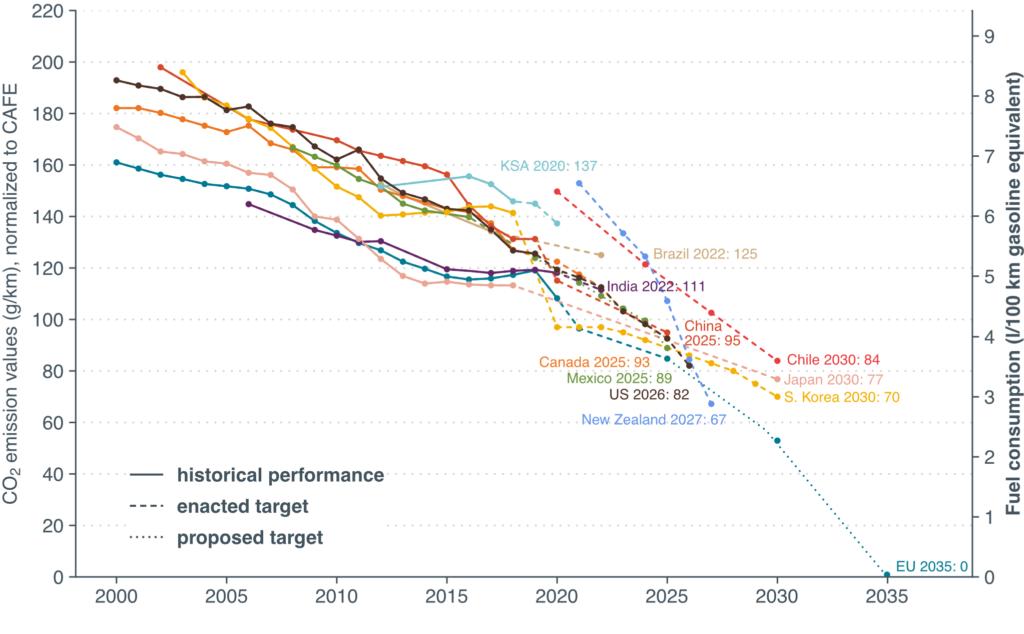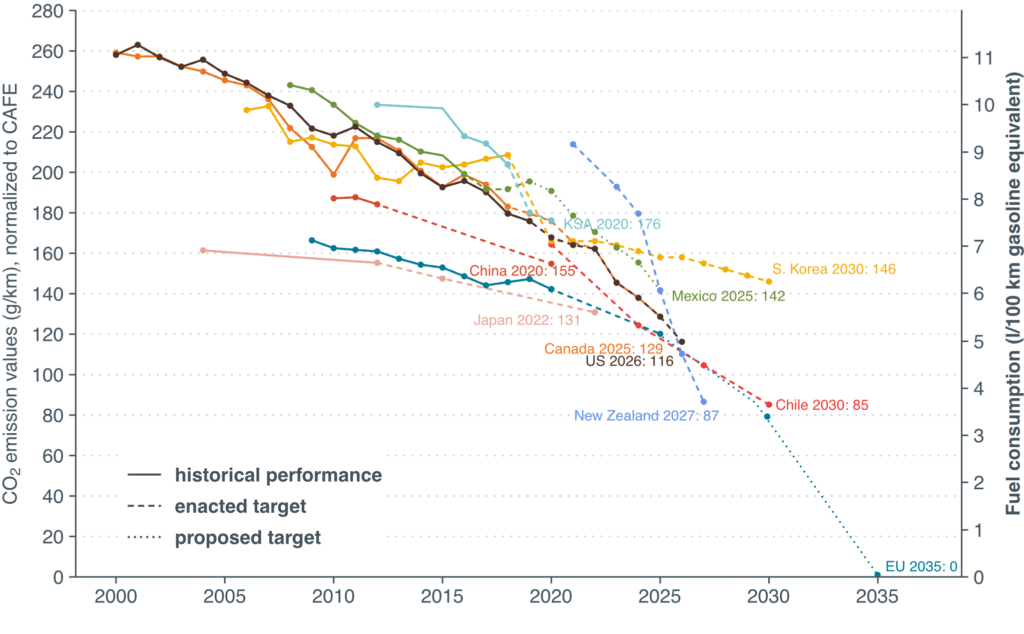Efficiency and GHG standards: LDV
Verified on 13 March 2024
Historical and projected GHG and fuel efficiency standards for passenger cars normalized to CAFÉ standards (gCO2/km) by applicable vehicle types

Source: ICCT research, please see table below for more details.
Historical and projected GHG and fuel efficiency standards for light trucks and vans normalized to CAFÉ standards (gCO2/km) by applicable vehicle types

Source: ICCT research, please see table below for more details.
GHG and fuel efficiency standards for light duty vehicles by applicable vehicle types
| policy_name | policy_status | policy_summary | publication_year | PC | LCV |
|---|---|---|---|---|---|
| US EPA Revised 2023 and Later Model Year Light-Duty Vehicle Greenhouse Gas Emissions Standards | adopted | Reducing fleet level emission for passenger cars and light trucks by 28% between 2022 and 2026 with annual targets. The baseline value for passenger cars in 2022 is 181 gCO2/mile and that for light trucks is 261 gCO2/mile. The test procedure is CAFE. | 2021 | Yes | Yes |
| Canada Regulations Amending the Passenger Automobile and Light Truck Greenhouse Gas Emission Regulations | adopted | Reducing fleet level emissions for passenger cars and light trucks by 30% between 2017 and 2025 with annual targets. The baseline value for passenger cars in 2022 is 221 gCO2/mile and that for light trucks is 312 gCO2/mile. The test procedure is CAFE. | 2014 | Yes | Yes |
| European Union Proposed CO₂ emission performance standards for cars and vans (Fit for 55) - GHG | proposed | Reducing fleet level emissions for passenger cars and vans by 100% in 2035. The base year is 2021. There are intermediate targets in 2025 (15% reduction from base year) and 2030 (55% reduction from base year). The baseline value for passenger cars in 2021 is 115 gCO2/km and that for light commercial vehicles is 176 gCO2/km. The test procedure is WLTP. | 2021 | Yes | Yes |
| China Phase V Fuel Efficiency Standard | adopted | Improving fleet level fuel efficiency for passenger cars from 5.8 l/100 km in 2019 to 4 l/100 km in 2025 and 3.2 l/100 km in 2030. The test procedure is NEDC. | 2019 | Yes | No |
| South Korea 2030 GHG Standard | adopted | Reducing fleet level emissions for passenger cars and light trucks by 28% in 2030. The base year is 2020. The baseline value for passenger cars is 97 gCO2/km and that for light commercial vehicles is 166 gCO2/km. The test procedure is CAFE. | 2021 | Yes | Yes |
| Japan Law Concerning the Rational Use of Energy 2019 Amendment | adopted | Reducing fleet level emissions for passenger cars by 28% in 2030. The base year is 2018. The baseline value for passenger cars is 128 gCO2/km. The test procedure is WLTP. | 2019 | Yes | No |
| New Zealand Clean Vehicle Act | adopted | Reducing fleet level emission for passenger cars and light trucks by 63% between 2021 and 2027 with annual targets starting from 2023. The base year is 2021. The baseline value for passenger cars is 169 gCO2/km and that for light trucks is 244 gCO2/km. The test procedure is WLTP. | 2022 | Yes | Yes |
| California Advanced Clean Car I (ACC I) GHG Standard | adopted | Reducing fleet level emission for passenger cars and light commercial vehicles by 50% between 2008 and 2025 with annual targets starting from 2017. The reduction from 2017 to 2025 is 33%. The 2008 value for passenger cars is 291 gCO2/mile and that for light trucks is 396 gCO2/mile. The 2017 value for passenger cars is 213 gCO2/mile and that for light trucks is 290 gCO2/mile. The test procedure is CAFE. Other Section 177 states also follow this standard. | 2012 | Yes | Yes |
| Chile LDV GHG Standard | adopted | Reducing fleet level fuel efficiency for passenger cars and light trucks by approximately 50% in 2030. The base year is 2020. The baseline value for passenger cars is approximately 14.9 km/lge and that for light commercial vehicles is approximately 13.5 km/lge. The test procedure is CAFE. | 2022 | Yes | Yes |
| Mexico LDV GHG Standard | proposed | Reducing fleet level emissions for passenger cars and light trucks by 36% and 26% respectively in 2025. The base year is 2018. The baseline value for passenger cars is 140 gCO2/km and that for light commercial vehicles is 192 gCO2/km. The test procedure is CAFE. | 2018 | Yes | Yes |
| US EPA Multipollutant Standards for LDV | proposed | Reducing emissions by 56% for LDVs, and 44% for Class2b_3 vehicles by 2032. The base year is 2026. The test procedure is CAFE. | 2023 | Yes | Yes |
| US CAFE Standards for Passenger Cars and Fuel Efficiency for HDPUV | proposed | Increase stringency at 2% per year for passenger cars and 4% per year for light trucks, year over year from MY2027-2032. Base year 2027. Increase stringency at 10% per year for HDPUVs, year over year from MY2030-2035. The base year is 2030. The test procedure is CAFE. | 2023 | Yes | Yes |
| Malaysia LDV GHG Standard | proposed | 2024-2026: National target of 123gCO2/k for passenger vehicles; 2027-2030: National target of 95 gCO2/km for passenger vehicles | 2021 | Yes | No |

